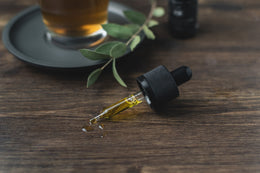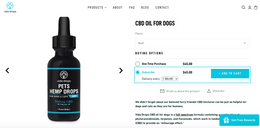How is CBD Oil Made? The Basics of CBD Extraction
CBD, or cannabidiol, is an extract that has been thrust into the spotlight by recent regulation changes across many states. CBD is extracted from Cannabis sativa plants that are carefully cultivated to minimize their THC content. Before California legalized medical marijuana in 1996, CBD had a small but loyal underground following that praised its pain-relieving qualities.
After that legalization, pharmaceutical groups began to investigate CBD more openly. The floodgates opened in 2011 when Charlotte Figi, a five-year-old girl suffering from Dravet Syndrome, was successfully treated using low-THC CBD oil. Her weekly 300+ grand mal seizures were reduced to just 2 or 3, with a dosage of 3-4 mg of high-quality CBD oil per pound of body weight each day.
CBD became legal on a federal level in 2018 and is legal in almost all 50 states as well. (Idaho, Iowa, and South Dakota are the holdouts.) In most cases however, you can find CBD oil in multiple forms, including lotions, edibles, and even flavored oils. Thanks to more states following California's lead, the road has been opened for federal legalization as well.
But how is CBD extracted from hemp plants and infused into CBD lotion, CBD gummies, and CBD oils?

There are three widely recognized methods, each with its benefits and drawbacks:
- oil extraction
- organic solvent extraction
- carbon dioxide (CO2) extraction
The extraction method can have a definite effect on the quality--and even safety--of the final product. We'll go through each one so that you understand what they are and how they work.
Extraction Basics
CBD is located in the glandular hairs of Sativa plants, and must be extracted to become usable in other forms. The plant (and the CBD it contains) must be dissolved in a solvent of some kind, and then the CBD can be extracted from that solvent in a useful form.
CBD isn't water-soluble, but it can be dissolved in other compounds, which is how the first two extraction methods work.
You might wonder why we bother with the CBD extraction process at all if CBD is found in the plant. The answer lies in bioavailability. CBD takes an acidic form in the plant (Cannabidiolic acid, or CBDA). While ongoing studies investigate the efficiency of raw Sativa (like a salad), proper extraction makes it easier for your body to use it.

Oil Extraction
This method of CBD extraction involves placing raw chopped up Sativa in an oil bath and heating it. CBD is pulled out of the plant by a chemical reaction called decarboxylation. By heating it, you chemically remove a carboxyl group from the CBDA, transforming it into CBD proper. This type of extraction is relatively easy to do and is the most common homebrew form of CBD extraction today.
Nearly any type of oil can be used for an CBD extraction, but keep in mind that you'll be either applying it to your skin or consuming it, so in most cases, olive oil or coconut oil is best.
As with any chemical reaction, the key is a combination of temperature, pressure, and time. By increasing any of these three reaction elements, you decrease the others. For example, if you increase the temperature used to decarb your Sativa, it takes less time. Likewise, if you drop the temperature, it takes more time.
Temperature and cook time vary according to who you ask. Some recommend temperatures as high as 240 degrees with an hour cook, while others stress a low and slow method that heats to 175 degrees Fahrenheit and cooks for a full 24 hours.
Keep in mind that the oil extraction method will result in the lowest overall extraction of CBD and the poorest purity. In most cases, the only reason to use this method is if you're a home-grower making a supply for personal use.
|
Oil CBD Extraction |
|
|
Advantages |
Inexpensive Easy to do with minimal equipment |
|
Disadvantages |
Extraction purity is extremely low Loss of vital terpenes Low purity means high volatility; the product must be stored in dark and cool places and used nearly immediately for best results. |
Solvent Extraction
If oil is one solvent, what are others?
Solvent extraction uses short-chain hydrocarbons like ethanol, isopropyl alcohol, butane, or hexane. This type of CBD extraction is restricted to professional manufacturers, because all these solvents are incredibly volatile. Additionally, the solvents must be completely removed from the CBD oil, or severe health complications can arise. (For example, ethanol consumption can be fatal.)
Solvent extraction involves taking the hydrocarbons in their liquid state and forcing them through a slurry of chopped up Sativa. The CBDA and terpenes are extracted from the plant and dissolve into the solvent. Next, the mixture is heated to encourage the evaporation of the solvent and trigger decarboxylation.
The end product is remarkably potent and, if done correctly, contains the full range of beneficial terpenes with the CBD. Unfortunately, the solvent used can bring other contaminants with it, including chlorophyll and other botanical impurities. In some cases, hydrocarbon residue can remain within the oil itself, giving it a strange flavor and causing side effects.
|
Solvent CBD Extraction |
|
|
Advantages |
Ultra pure product Very fast compared to oil extraction |
|
Disadvantages |
Uses hydrocarbons which can leave behind residual flavors and possible side effects Extremely dangerous to perform outside of a controlled laboratory environment End product may contain plant contaminants including chlorophyll |

CO2 Extraction
The CBD extraction process that utilizes carbon dioxide, called CO2 Extraction or Supercritical CO2 Extraction, is very similar to that of organic solvents. Liquid carbon dioxide is pressed through Sativa plant matter to extract the CBD and terpenes.
Under standard temperatures and pressures, CO2 is a gas. However, it forms a solid--you may know it as dry ice--very easily. Usually dry ice sublimates (transforms directly from a solid to a gas), but it can be turned into a liquid if kept at low temperature and high pressure.
Liquid carbon dioxide behaves like the other organic solvents and pulls the desired substances (CBD and terpenes, among other compounds) out of the plant. However, unlike harsh chemical solvents like hexane, carbon dioxide evaporates from the CBD easily and quickly. Better still, the process is a closed-loop system: carbon dioxide is turned from gas to liquid for extraction, and then evaporated back to a gas to be used all over again.
Carbon dioxide CBD extraction is a totally safe process that is also used in other industries to decaffeinate coffee and extract essential oils from other plants. On the off chance that a bit of carbon dioxide is left in the CBD, it'll quickly dissipate as a harmless gas. The end product is exceptionally pure and ready for processing with no added contaminants.
|
Carbon Dioxide CBD Extraction |
|
|
Advantages: |
End product is exceptionally pure Complete extraction of terpenes and CBD Totally safe with no unwanted contaminants |
|
Disadvantages: |
Expensive startup Requires specialized equipment and well-trained chemists |
Putting It All Together
It's easy to see that carbon dioxide extraction is the best method for getting the purest, most high quality, and safest CBD possible. Unfortunately, the expertise and cost required puts this method out of reach for both home enthusiasts and corner-cutting manufacturers.
Chemical solvent extraction is incredibly dangerous and should never be attempted outside of carefully controlled environments. Oil extraction, while easy to do, will create end products with wide variance in purity, reliability, and concentration. If you're concerned about those qualities, purchasing CBD oil from a reputable source is paramount.
Knowing how CBD is extracted empowers you to make informed decisions about where you spend your hard-earned money. At Vida Drops we're committed to producing only the best, which is why we never hesitated to invest in supercritical CO2 CBD extraction to create exceptionally pure CBD products for your use. Your health and safety are just as important to us as they are to you, which is why our CBD is clearly labeled and consistently tested in an independent lab for purity and concentration.
If you have any questions about our process, please reach out to us. You can also subscribe to our email newsletter for news, deals, and updates on our CBD products.






